
Ever found yourself craving that morning coffee fix only to realize the power’s out? Do you know, how to make coffee without electricity? Been there, done that. In this guide, I’ll share my journey of discovering alternative coffee brewing methods when electricity isn’t an option.
When life throws you a power outage, knowing how to brew coffee without electricity becomes a game-changer. It’s about turning an inconvenience into an opportunity for adventure. Join me as we explore some ingenious ways to enjoy a cup of joe, even when the lights are out.
How to make coffee without electricity: 4 Best Traditional Methods
Well, I suggest starting with the very basics, simple and more traditional methods.
Boiling water over an open flame
Imagine the situation: you woke up on a Sunday morning with the desire to drink a cup of invigorating coffee before starting an active weekend, but there is no electricity. And if on a weekday you ran to the shopping center for a cup of espresso, now you don’t want to rush anywhere
So, How to Boil Water When the Power is Out? No problem.… I hope you have a few logs at home, then you can easily make a fire and cowboy coffee, right?
I know that you actively go outdoors, bask in the rays of the sun, which means you should have a camp kettle. I think you already understand what I mean – just pour water into it and heat it over a fire.
Once the water was boiling, I added a generous spoonful of coffee grounds and let them sit for a few minutes.
With a steaming cup of coffee in hand, I took a moment to savor the rich, smoky flavor of the brew made by the fire.
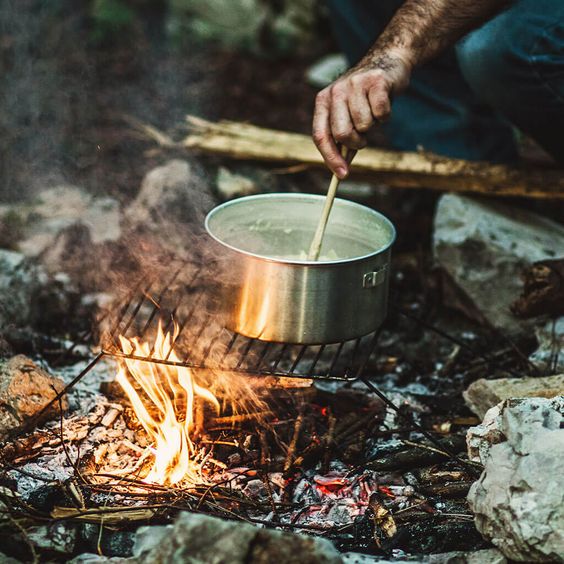
Using a stovetop percolator or Moka pot
This method is often used by a friend of mine, so I am sharing it with you. For this you only need a percolator. Here’s how I brew coffee without electricity:
- I filled the bottom chamber of the percolator with water, just below the safety valve.
- I added a couple of spoons of my favorite coffee grounds to the filter basket.
- I placed the fully assembled percolator on an open fire, whether it be a gas stove, a campfire, or any other suitable heat source. Since my friend often goes camping, he has an excellent metal sheet on which it is convenient to place both a kettle and a pot for heating. If you don’t have one, then I recommend making something like an arch where you can hang the percolator.
- As the water heated, I eagerly listened for the telltale gurgling sound, which is a sign that my coffee was brewing.
Having finished brewing, I poured myself a cup of hot coffee, enjoying its rich aroma and bright taste.
French press without electricity
The French press has been a staple in my coffee routine for years, and it’s a favorite of my mom’s too. Here’s how we brew coffee without electricity using this reliable method:
- I start by heating water on a gas stove or over an open flame, with my mom patiently waiting alongside me for it to reach the perfect temperature.
- While the water heats up, my mom helps me measure out some coarsely ground coffee beans and adds them to the French press, getting everything ready for brewing.
- Once the water is hot enough, I carefully pour it over the coffee grounds in the French press, making sure they’re fully immersed, while my mom observes with anticipation.
- With the lid on, we let the coffee steep for a few minutes, allowing the flavors to develop and intensify as we chat about the day ahead.
- After the steeping time is up, I press down the plunger slowly, separating the grounds from the brewed coffee, with my mom eagerly watching the process.
Finally, we pour ourselves cups of the rich, aromatic coffee, enjoying the moment together and savoring the warmth of both the coffee and each other’s company.
Turkish coffee brewing technique without electricity
Even without electricity, I managed to recreate the vibrant flavors of Turkish coffee by improvising with traditional methods.
- After meticulously grinding my coffee beans into a fine powder, I carefully measured out the cold water and poured it into my beloved cezve, the iconic Turkish coffee pot.
- When it comes to grinding coffee beans without electricity, I’ve learned to rely on manual methods like a hand-operated coffee grinder, mortar and pestle, or even a trusty hammer in a pinch. These methods ensure I always have freshly ground coffee on hand for brewing, even in off-grid situations.
- Now all I have to do is heat the cezve and pour the drink into cups. Relax and enjoyment even without electricity.
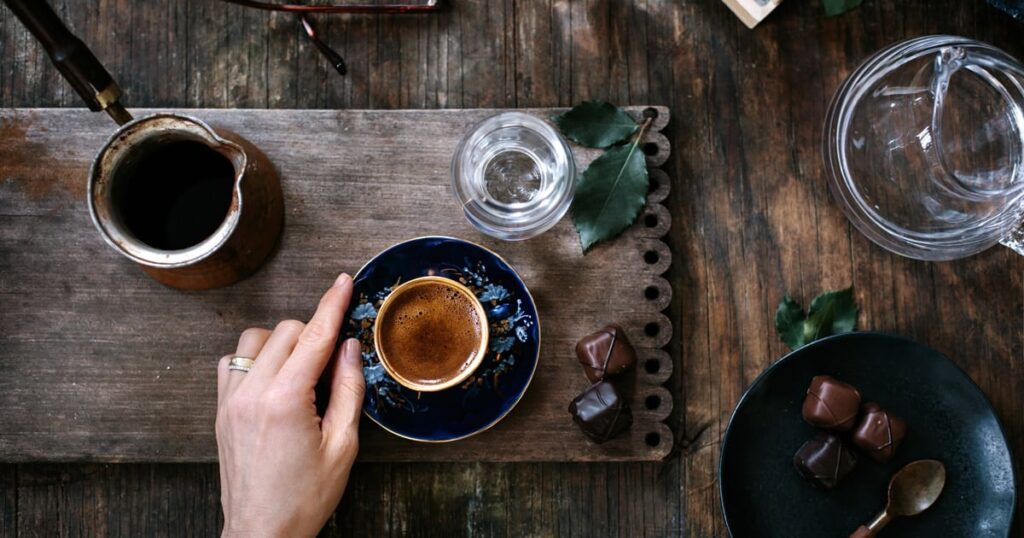
How to make coffee without electricity: Cold Brew Method
Let’s delve into the world of cold brew coffee – a method my friend Matthew introduced me to during a power outage, and I’ve really grown to love it for its smooth, rich flavor profile. Just imagine: coarse coffee grounds steeping in cold water for an extended period.
Step-by-Step Guide to Making Cold Brew without Electricity
- Matthew, who faced the same power outage, advised grinding the coffee beans to a coarse consistency. This ensures that you get the best flavor extraction during the steeping process. Personally, I’ve found this step crucial for unlocking the full potential of the coffee’s flavor.
- Then, I combined the ground coffee with cold water in a large container. For a stronger brew, aim for a ratio of 1:4 coffee to water. But feel free to adjust according to your taste.
- Patience is key. Matthew shared his experience of letting the mixture steep at room temperature for 12-24 hours. This slow extraction allows the natural oils and flavors of the coffee to infuse into the water, resulting in a robust concentrate. I’ve learned that patience truly pays off in achieving a smooth, flavorful cold brew.
- Once it had steeped, I strained the mixture using a fine-mesh sieve or cheesecloth to remove the grounds, a step crucial for achieving a smooth, grit-free cold brew. It’s amazing how much of a difference this simple step makes in the final product.
- I diluted the concentrate with equal parts water or milk, depending on my preference. Pour it over ice for a refreshing drink or enjoy it straight for a real caffeine kick. The versatility of cold brew never ceases to amaze me.
Tips for Achieving the Best Flavor Profile
- Not to be afraid to play around with different types of coffee beans, grind sizes, and steeping times until you find your perfect brew. In my experience, this experimentation is indeed essential to tailor the cold brew to your taste preferences.
- Always use high-quality, freshly roasted beans for the best flavor experience. It’s definitely worth the investment, and I wholeheartedly agree. Starting with good beans sets the foundation for a great cold brew.
- Store the cold brew concentrate in the refrigerator for up to a week to keep it fresh and flavorful, a tip I found practical and effective. Proper storage ensures that you can enjoy your cold brew for days to come.
- Customize your cold brew with flavored syrups, spices, or alternative kinds of milk to add your own personal touch. After all, coffee is all about enjoyment and experimentation, a sentiment I couldn’t agree with more. The possibilities are endless when it comes to customizing your cold brew experience.

Manual Brewing Methods Coffee without Electricity
In these methods, I grind the coffee beans in a burr coffee grinder.
Pour-over Coffee Technique without Electricity
When there’s no electricity, I turn to the comforting ritual of pour-over coffee. Here’s how I make it happen:
- I start by heating water on a gas stove or a camping burner. It’s crucial to aim for a temperature between 195°F to 205°F (90°C to 96°C) for the best flavor extraction.
- While waiting for the water to heat, I grind my coffee beans to a medium-fine consistency, ensuring optimal flavor extraction.
- I place a paper filter in my pour-over dripper and rinse it with hot water. This not only preheats the brewing vessel but also removes any papery taste from the filter.
- I evenly distribute the ground coffee into the filter, taking care to ensure uniform saturation.
- Slowly, I pour hot water over the coffee grounds in a circular motion, starting from the center and spiraling outward, ensuring thorough saturation.
- After letting the coffee bloom for about 30 seconds, I continue pouring water in a steady stream. The entire brewing process usually takes around 2 to 3 minutes.
- Once the coffee has finished dripping, I remove the dripper, discard the filter, and pour myself a soothing cup of pour-over coffee. It’s a simple yet satisfying way to start the day.
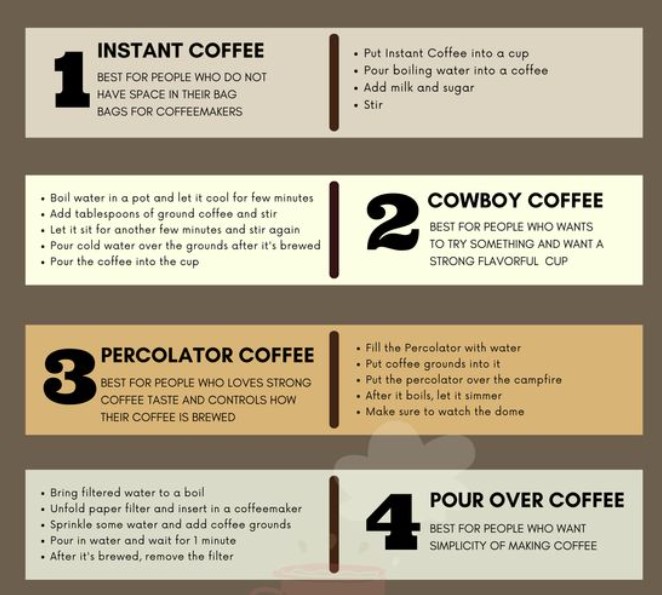
AeroPress Brewing Process without Electricity
The AeroPress is my go-to brewing method, even without electricity. Here’s how I make it work:
- I use a gas stove or camping burner to heat water to around 175°F to 185°F (79°C to 85°C), ensuring a smooth extraction.
- I insert a paper filter into the AeroPress cap and rinse it with hot water, preheating the device and removing any paper taste.
- I place finely ground coffee into the AeroPress chamber, then slowly pour in the hot water until it reaches the desired level.
- After giving the coffee and water mixture a quick stir, I let it steep for about a minute to ensure even extraction.
- With the filter cap attached, I invert the AeroPress onto my cup and slowly press down the plunger until I hear a hissing sound, indicating that all the liquid has been extracted.
- After removing the AeroPress, I dilute the concentrate with hot water to my liking and relish the bold flavors of my freshly brewed coffee.

Manual Espresso Makers without Electricity
Who says you need electricity for espresso? Here’s how I brew it manually:
- Using a gas stove or camping burner, I heat water to about 195°F to 205°F (90°C to 96°C), the ideal temperature for While the water heats, I grind my coffee beans to a fine consistency, similar to table salt.
- I assemble my manual espresso maker according to the manufacturer’s instructions, preheating it with hot water for thermal stability.
- Into the filter basket, I place the freshly ground coffee, then pour hot water into the water chamber.
- Placing the espresso maker on the heat source, I wait until the water boils and espresso flows into the upper chamber, monitoring the process to avoid over-extraction.
- Once brewed, I pour the espresso into my cup, savoring its bold flavor and rich crema, relishing in the simplicity and satisfaction of manual brewing.
In the absence of electricity, these manual brewing methods not only provide a solution but also offer a chance to appreciate the art and craft of coffee making.
Camping and Outdoor Solutions To Make Coffee Without Electricity
I go camping a lot, so I’m prepared for the fact that there won’t be electricity there. But my morning cup of coffee is always waiting for me with these methods.
Portable coffee makers suitable for camping without electricity
When I’m out camping and need my caffeine fix without electricity, I rely on portable coffee makers. Here are some options that have served me well:
- French Press. A trusty companion for outdoor adventures, the French press is simple to use and requires only hot water and coarse coffee grounds. I love the ritual of steeping, plunging, and enjoying freshly brewed coffee amidst nature’s beauty.
- Portable Espresso Maker. For a more intense coffee experience, I opt for a portable espresso maker. These compact devices are hand-operated, making them perfect for camping trips where electricity is scarce. There’s nothing quite like sipping on a shot of espresso while taking in the crisp morning air.
- Pour-over Travel Dripper. When I want the convenience of pour-over coffee on the go, a travel dripper fits the bill perfectly. Its compact size and ease of use make it a favorite for brewing a delicious cup of coffee wherever my adventures take me.
- Collapsible Coffee Dripper. Minimalist and practical, collapsible coffee drippers are my go-to for backpacking trips. I appreciate how they fold down to a compact size, saving space in my pack while still delivering a satisfying brew.
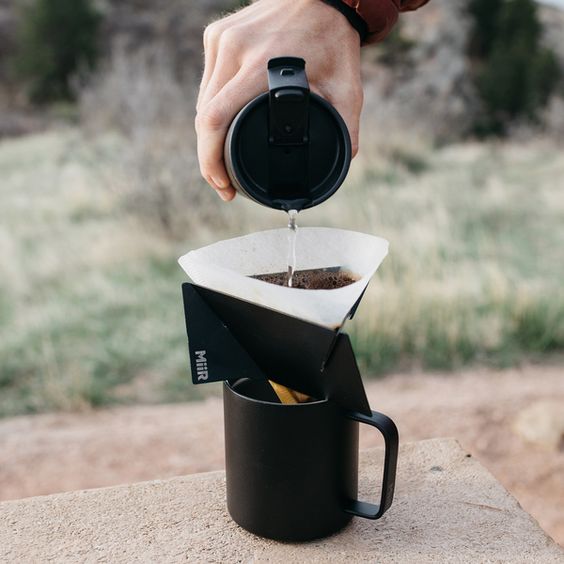
Instant coffee options for outdoor enthusiasts without electricity
When I’m out exploring the great outdoors and don’t have access to electricity, instant coffee is my go-to for a quick caffeine boost. Here are a few options I always keep on hand:
- Instant Coffee Packets. These pre-portioned packets are lightweight and easy to pack, making them perfect for camping trips. I simply mix them with hot water for a quick and satisfying cup of coffee on the trail.
- Instant Espresso Powder. For a stronger flavor, I turn to instant espresso powder. Its quick dissolving nature makes it ideal for busy mornings or chilly evenings around the campfire. Nothing beats the rich and robust flavor of a good espresso, even in the wilderness.
- Cold Brew Concentrate Packets. When I’m craving something refreshing, cold brew concentrate packets are my go-to. I mix them with water or milk for a smooth and invigorating cold brew coffee, perfect for hot summer days spent hiking or relaxing by the lake.
How to make coffee without electricity: Emergency Situations
It is useful information for you.
Coffee-making strategies during power outages or emergencies
During power outages or emergencies, I’ve developed some strategies to ensure I still get my coffee fix. Here’s what I do:
- When the power’s out, I turn to manual brewing methods like the French press, AeroPress, or pour-over. These methods don’t require electricity and rely on hot water heated on a gas stove or camping burner.
- Instant coffee becomes my go-to in emergencies. It’s quick and convenient, requiring only hot water for preparation. While it may not offer the same complexity as freshly brewed coffee, it gets the job done when traditional methods aren’t an option.
- For longer outages, I prepare cold brew concentrate in advance. Cold brew doesn’t require heat for brewing, and the concentrate can be diluted with water or milk for a refreshing coffee drink.
Using alternative heat sources for boiling water
When electricity is out, alternative heat sources become essential for boiling water. Here’s what I rely on:
- I use a gas stove or camping burner to heat water for brewing coffee. These portable heat sources are reliable and efficient, making them perfect for emergencies.
- If I’m outdoors, I use an outdoor grill or campfire to boil water. I place a pot or kettle over the flames and monitor the water until it’s ready for brewing.
- For indoor use during power outages, I have a portable propane heater on hand. It allows me to safely heat water indoors, as long as I ensure proper ventilation.
Creative solutions for making coffee without traditional tools
In emergencies, I’ve had to get creative with coffee-making. Here are some solutions I’ve tried:
- When I’ve run out of paper filters, I’ve used clean cloth or cheesecloth as makeshift filters. It’s a simple solution that gets the job done in a pinch.
- To mimic the intensity of espresso without an espresso machine, I’ve brewed a concentrated coffee using finely ground coffee and a small amount of water. It’s not quite the same, but it satisfies my craving for a strong coffee fix.
- In sunny weather, I’ve experimented with solar-powered brewing methods. Using reflective surfaces like mirrors or aluminum foil, I concentrate sunlight to heat water for brewing coffee.
How to make camping coffee: Tips and Tricks
Based on my experiences, here are some tips for successful coffee-making without electricity:
- Transfer brewed coffee to a thermos to keep it hot for longer periods, ensuring you can enjoy multiple cups throughout the day.
- Pre-grind coffee beans before an emergency to save time and have coffee ready to brew when needed. Store pre-ground coffee in an airtight container to maintain freshness.
- Keep a supply of instant coffee, filters, and other essential coffee-making supplies in your emergency kit to be prepared for unexpected situations.
Troubleshooting common issues
In emergency coffee-making situations, I’ve encountered common issues and learned how to troubleshoot them:
- Adjust the placement of the brewing vessel to ensure more uniform heating if the heat source is inconsistent.
- Prioritize water usage for brewing coffee and conserve water by using it sparingly for other purposes if water supply is limited.
- Improvise with alternative brewing methods or tools if a brewing device malfunctions to ensure you can still brew coffee.
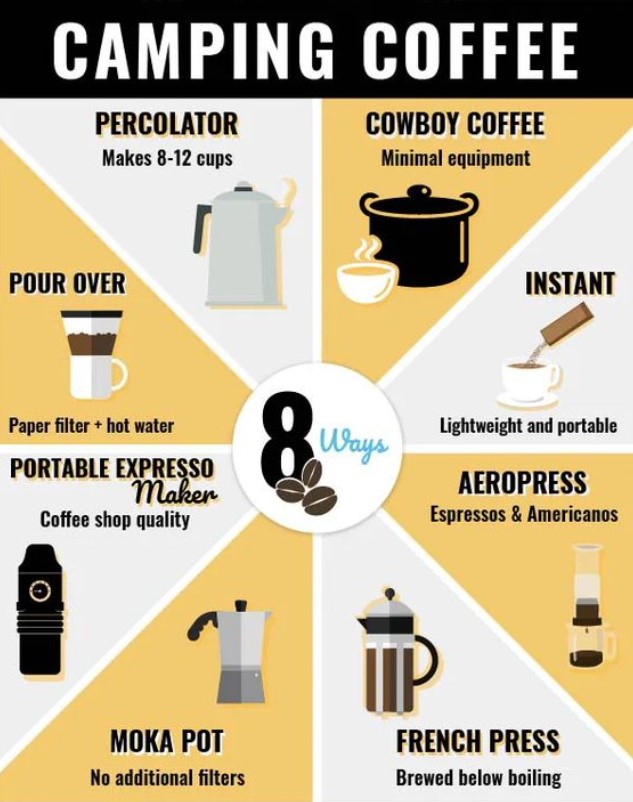
Recommendations for equipment and tools to have on hand
To be prepared for coffee-making without electricity, I recommend having the following equipment and tools on hand:
- Invest in durable and portable manual brewing devices such as a French press, AeroPress, or pour-over dripper.
- Keep a portable gas stove, camping burner, or alternative heat source in your emergency kit for boiling water.
- Stock up on instant coffee, pre-ground coffee, filters, and other essential coffee supplies to have on hand during emergencies.
Conclusion
Based on my own experiences, I’ve found that brewing coffee without electricity requires resourcefulness and adaptability. Whether it’s using manual brewing methods like the French press or finding alternative heat sources for boiling water, there are always ways to enjoy a satisfying cup of coffee, even in challenging situations. Despite the limitations, the process fosters a sense of creativity and connection to the craft of coffee-making, making each cup all the more rewarding.
FAQs
What can I use as an alternative heat source for boiling water?
If you don’t have access to electricity, you can use a gas stove, outdoor grill, campfire, or portable propane burner to boil water for coffee-making.
How can I grind coffee beans without electricity?
You can grind coffee beans manually using a hand-operated coffee grinder, mortar and pestle, or even a hammer and sturdy plastic bag.
Can I make coffee without traditional brewing tools?
Yes, you can get creative and improvise with makeshift tools. For example, you can use a clean cloth or cheesecloth as a filter, or brew coffee directly in a pot over a campfire for a rustic cowboy coffee experience.
What types of coffee are best suited for making without electricity?
Coarsely ground coffee works well for methods like French press and cold brew, while finer grinds are better for pour-over and AeroPress. Experiment with different coffee beans and grind sizes to find what you enjoy most.
How can I ensure my coffee stays hot without a heating element?
Preheat your coffee cups or use a thermos to keep brewed coffee hot for longer periods without the need for a heating element.
Are there any tips for troubleshooting common issues when making coffee without electricity?
If your water isn’t heating evenly, try adjusting the position of the pot or kettle over the heat source. If your coffee tastes too weak or too strong, experiment with adjusting the coffee-to-water ratio until you find the perfect balance.
How long does it take to make coffee without electricity using these methods?
The time it takes to make coffee without electricity varies depending on the brewing method and the heat source used. Generally, it takes around 5-10 minutes to heat water and brew coffee using manual methods like French press or pour-over. Cold brew, on the other hand, requires an extended steeping period of 12-24 hours.

Hello, coffee enthusiasts! I’m Nancy Gregory, a seasoned coffee sommelier eager to share the exquisite world of coffee with you. I love coffee with every fiber of my soul and I know a lot of interesting information about beans and coffee brewing methods that I want to share with you.